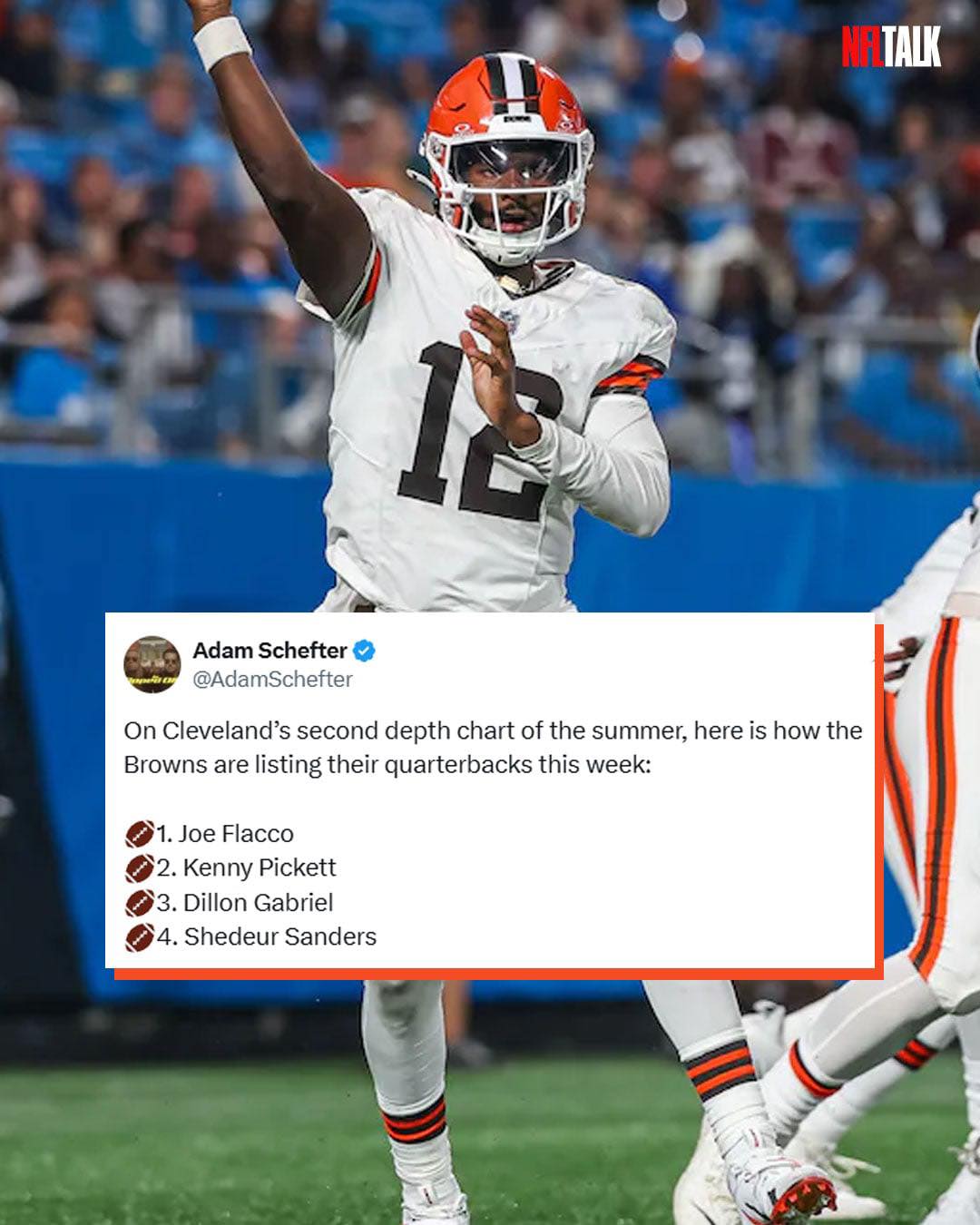The Browns have recently unveiled their updated quarterback depth chart, and despite Shedeur Sanders’ impressive performance in his first preseason start, it appears that the coaching staff has not adjusted his position on the depth chart in a significant way. His standout game, which showcased his potential and poise under pressure, unfortunately did not translate into a higher ranking among the Browns’ quarterback options. This decision by the coaching staff to keep Shedeur at the bottom of the depth chart raises several points worth exploring, from team strategy and player development philosophies to the pressures and expectations surrounding rookie quarterbacks, especially those with a famous football lineage.
Shedeur Sanders, coming into the NFL with considerable buzz and high expectations, carries the weight of being the son of Hall of Famer Deion Sanders. The spotlight on Shedeur has been intense from the moment he entered the league, with fans and analysts eager to see if he could replicate some of his father’s athletic prowess and competitive edge. In his first preseason start, Shedeur showed flashes of brilliance — demonstrating accuracy, calm decision-making, and an ability to read defenses that many rookie quarterbacks struggle with early in their careers. His completion percentage was impressive, and he showed a knack for extending plays, buying time in the pocket, and finding receivers downfield with confidence. However, despite this promising debut, the Browns’ coaching staff seems to be adopting a cautious approach, opting to keep Shedeur in a developmental role rather than pushing him up the depth chart prematurely.
This conservative stance likely reflects the Browns’ broader strategic approach to quarterback development. The team currently has other quarterbacks ahead of Shedeur, some with more NFL experience or who better fit the offensive system the Browns are running. Teams often value experience and familiarity, particularly at such a critical position, and it’s not uncommon for promising rookies to begin their careers further down the depth chart. The rationale here is to allow these young players time to adjust to the speed and complexity of professional defenses, to refine their mechanics, and to absorb the playbook fully before being thrust into high-pressure game situations. In Shedeur’s case, the coaching staff’s decision suggests a belief that, while he is talented, he is not yet ready to take on a starting or even backup role that demands consistent execution against NFL defenses week after week.
The Browns’ quarterback situation is complicated, with the presence of veterans and perhaps more polished signal-callers making the competition stiffer. NFL teams rarely hand the reins to a rookie quarterback unless there is an urgent need or the rookie is an obvious standout. Even though Shedeur’s preseason performance was encouraging, the sample size remains limited. Preseason games, while valuable, often feature a mix of starters and backups, and the intensity and stakes are not comparable to regular-season matchups. Coaches tend to look beyond raw numbers and flashy plays; they assess a player’s decision-making under duress, their grasp of the offense, their leadership qualities, and their ability to consistently perform across multiple games. It may be that the coaching staff feels Shedeur needs to develop these intangibles further before earning a more prominent role.
Another factor at play is the pressure that comes with being a high-profile rookie quarterback. Expectations can be both a blessing and a curse. For Shedeur, being the son of Deion Sanders adds a layer of scrutiny that can make the learning curve steeper. Media coverage often magnifies every success and failure, creating a narrative that may not always align with a player’s actual readiness or growth trajectory. Coaches might be deliberately shielding Shedeur from this pressure by keeping him lower on the depth chart, allowing him to grow without the full glare of starting quarterback scrutiny. This approach can help preserve confidence and focus, which are essential for any young quarterback’s long-term development.
It is also important to consider the Browns’ immediate goals as a team. Are they in a “win-now” mode where veterans are prioritized to maximize the chances of success this season, or are they in a rebuilding phase where giving a rookie valuable playing time is part of a longer-term strategy? The answer to this question often dictates how teams handle their quarterback depth charts. If the Browns believe they have a realistic shot at contending this year, it would make sense to rely on quarterbacks who are more proven, at least in the short term. Conversely, if the team is focusing on building for the future, one might expect more opportunities for Shedeur. However, the fact that he remains at the bottom suggests that the Browns want to strike a balance — integrating Shedeur gradually rather than rushing him into a starting role he may not be prepared for yet.
Shedeur’s rookie contract and draft status might also play a role in the team’s approach. Often, players selected in later rounds or signed as undrafted free agents face an uphill battle to climb the depth chart quickly. If Shedeur was drafted or signed under certain contractual terms that give the Browns flexibility, the team might feel less urgency to push him into a major role prematurely. They can afford to be patient, watching him develop in practice and limited game action, before making a more significant commitment.
Moreover, quarterback development is rarely linear or straightforward. Many highly touted prospects have struggled early in their careers before eventually blossoming into successful starters. Conversely, some players who show early promise can stall or regress if thrust into action too soon. Coaches and front office personnel need to evaluate a variety of factors — from mental toughness to physical readiness to compatibility with the team’s offensive scheme — before making decisions about who moves up the depth chart. Shedeur’s position at the bottom now does not mean he won’t climb higher in the future; it simply reflects the current assessment of his readiness and the team’s priorities.
Shedeur’s preseason outing, while impressive, is just one piece of a much larger puzzle. Consistency will be key going forward. The Browns and their coaching staff will be watching closely as he continues to practice, learn the system, and potentially get more game reps. If Shedeur continues to show growth and adaptability, his position on the depth chart could change quickly. It’s not uncommon for rookie quarterbacks to start slow and then seize opportunities created by injuries or performance issues elsewhere on the roster. Being patient and steady often pays dividends in the NFL, where the mental aspect of quarterbacking is as important as the physical.
From the fans’ perspective, this might be a frustrating development. Shedeur’s first start gave a glimpse of excitement and potential, and many might have hoped it would translate into a more prominent role. However, it’s important to recognize the complexities involved in quarterback management at the professional level. The Browns’ coaching staff likely wants to avoid the pitfalls that can come with rushing a young quarterback, such as loss of confidence or undue pressure. By keeping Shedeur lower on the depth chart for now, they are arguably protecting both him and the team’s long-term interests.
In conclusion, while Shedeur Sanders’ first preseason start was a bright spot and showcased his potential as an NFL quarterback, it did not move the needle enough to elevate his position on the Browns’ quarterback depth chart. This outcome is a reflection of the team’s cautious and strategic approach to quarterback development, the presence of more experienced players ahead of him, the pressures associated with his high-profile background, and the team’s immediate goals. Shedeur remains a player with promise and a future that could very well include a larger role with the Browns, but for now, the coaching staff seems committed to a patient, measured path to his development. The journey for rookie quarterbacks in the NFL is often challenging, and how Shedeur responds to this period of growth and preparation will be crucial in determining his trajectory moving forward. The Browns appear to be playing the long game, prioritizing sustainable development over immediate gratification, and only time will tell if that approach will pay off for Shedeur and the franchise.



